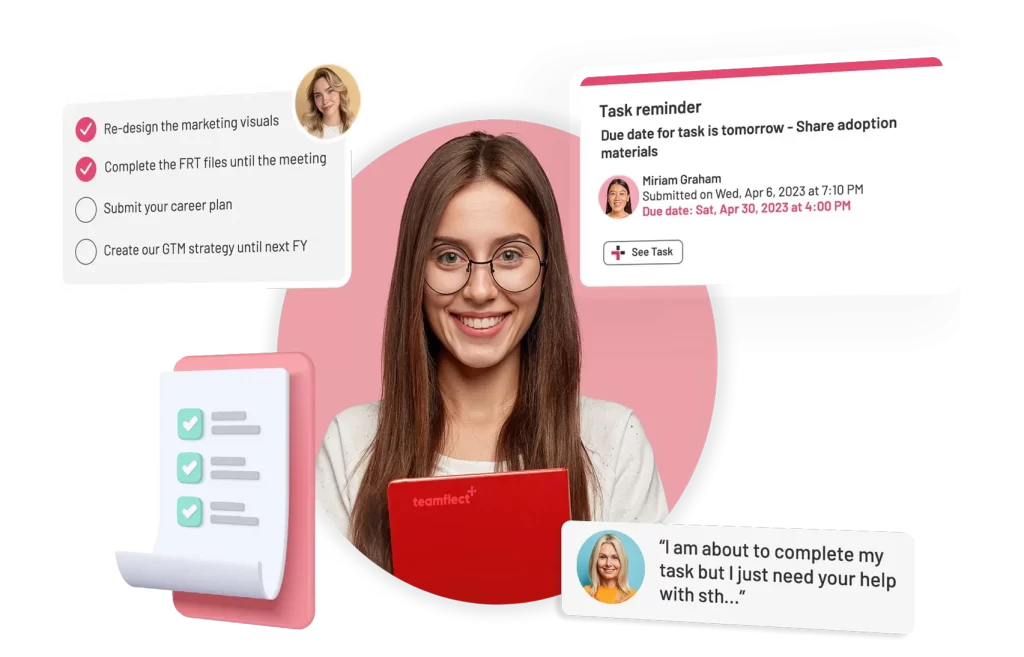Maintaining employee engagement is hard enough. In a remote setting, this concept becomes even more complex, turning remote employee engagement into one of the key factors in running a remote business.
The question in everyone’s mind is “How to increase remote employee engagement?”. Be it through recognitions, rituals, or localization of remote employees, there are many virtual employee engagement ideas.
As fellow members of a fully remote business, we here at Teamflect enjoy doing our part in providing whatever assistance we can to existing remote businesses or businesses that are planning on making the switch to a remote model and taking on the exciting world of remote employee engagement.
Table of Contents
1. Recognitions & Remote Employee Engagement
The video game industry has relied on achievements and badges incredibly successfully to keep their players engaged for a very long time and it works incredibly well for them.
There is no reason for that system to not be used in increasing remote employee engagement in other fields. The sense of isolation that remote working could bring may bring with it the notion that one’s accomplishments would go unnoticed.
That is why having a system for employee recognition to show that your employees are appreciated even in a remote setting is absolutely crucial in ensuring remote employee engagement.
These recognitions should be custom-tailored to your institution to support company culture. Performance management software such as Teamflect offers this service in a pretty easy-to-use manner.
You can even implement nonmonetary incentives with your recognitions simultaneously, as a way to show appreciation to your workforce, helping increase their overall job satisfaction.
2. The Virtual Water Cooler
It wouldn’t be a ground-breaking statement to suggest that humans are social creatures and that working in an isolated manner from one’s fellow coworkers has an adverse effect on remote employee engagement. Even in a remote setting, employees benefit heavily from having a relationship with their coworkers that goes deeper than the fact that they work for the same company.
Having a virtual chatroom that is always accessible and has nothing to do with the tasks is one of the fun ways to engage remote employees.
Software like Microsoft Teams or Discord is perfectly suitable in this regard. Brick-and-mortar offices may not be as necessary as they were anymore, but when it comes to remote employee engagement ideas, a virtual coffee house or water cooler is a must!
3. 360 Degree Feedback
Many of the discussion topics surrounding remote employee engagement boil down to one incredibly powerful notion: Being heard. Encouraging a transparent and consistent 360 feedback culture whether through 1-on-1 meetings or self-review templates is extremely beneficial.
We here at Teamflect believe that effective feedback isn’t a simple one-way or two-way street. Effective feedback, the backbone of remote employee engagement, stems from well-established company culture and goes 360 degrees. As far as metaphors are concerned, a neighborhood, as opposed to a street.
4. Localize Your Remote Team
When the question of “How can I keep my remote employees engaged?” was at its most prominent, being remote wasn’t a choice, but a must. Now with the world opening up, it is simply an alternative. That is why there is no reason for employees working in a remote setting to stay away from each other.
Organizing meet-ups, pop-up events, and retreats work wonders in remote employee engagement, bringing a much welcome sense of locality to the remote workforce.
5. Avoid Micromanagement in Remote Workforce Management
While consistent weekly check-ins are more than welcome and effective in remote employee engagement, managers should fight the urge to contact their employees too often.
Working towards an achievable yet challenging common goal at one’s own pace is one of the most liberating aspects of working in a remote model. Too much communication can lead to a sense of micromanagement much faster than it does in a non-remote setting.
A short and concise video call where goals are defined clearly is worth a hundred pesky e-mails. Using performance management software with a simple dashboard that allows employees to keep track of their OKRs at their own pace is worth even more.
At the end of the day, remote employee engagement and remote workforce management rely heavily on values like freedom and mutual trust.
6. Facilitate Collaboration
Isolation is more likely to occur with a remote workforce, which will elevate the risk of disengagement.
Teams can be formed across various departments for particular projects based on the varying skills required to complete the tasks. This will create a culture of collaboration.
And facilitating remote employee engagement with the culture of collaboration will allow your employees to learn how to work as teams and they will set aside their agendas by being more team-oriented.
7. Create an Inclusive Working Environment
You might experience difficulties in a remote working environment like isolation, and poor communication. You can improve your performance and satisfaction by developing trust, chemistry, and empathy with your coworkers, clients, and business partners through an inclusive community.
To achieve this you need to create inclusive policies that encourage flexibility while maintaining accountability for workers. Being able to access executives and information, bias training, and making sure all employees participate in team-building exercises are a few suggestions.
8. Offer Professional Growth Opportunities
If your employees feel like their professional development is becoming stagnant because of remote work, disengagement will quickly increase and motivation could rapidly deteriorate.
Providing remote workers the opportunity to use mentorship programs, shadowing activities, and access to online learning environments such as edX are excellent ways to support them in developing the expertise they need to contribute to the success of your company.
Remote employees are more inclined to be engaged if they are comfortable with their development strategy.
9. Prioritize Employee Well-Being
By demonstrating empathy, you can improve employee well-being because it will allow them to know that they are valued.
Normalize everyday interaction, and don’t be afraid to host remote employee wellness support and training sessions using mobile apps or software. Offering mental health benefits to your employees demonstrates your concern for them.
There are numerous ways that your business can help employees with their psychological and physical wellness. This entails being aware of the mental health status of your employees and how much work-related stress affects them. Then you can incorporate more flexible work schedules to strike a healthy work-life balance.
10. Create a Great Onboarding Experience
Creating a sense of belonging online may not be so easy. But it’s an important method for increasing remote employee engagement. To achieve this, you need a well-defined remote onboarding strategy.
After establishing a solid strategy, you can provide the new hires with the essential software they will be using and important information such as login credentials.
Having feedback sessions, providing them with mentoring opportunities, and asking for their feedback are among other practices of remote engagement of employees.
Benefits of Remote Employee Engagement
Some organizations don’t prioritize employee engagement because they don’t believe that it’s worth the effort. But, it can do wonders for boosting employee morale and productivity.
The reasons why remote employee engagement is so important include:
- Boosts job satisfaction and consequently employee retention.
- Improves collaboration and teamwork.
- Increases productivity.
- Promote creative efforts.
- Facilitates onboarding processes.
Best Way to Increase Remote Employee Engagement
Set up Software for Team Communication

There are limited chances for remote employees to interact in person with their coworkers. But we’re fortunate to live in a world where we have access to a wide range of communication platforms. And Teamflect is one of these platforms.
Using Microsoft Teams, you can chat with your remote team members and have video calls to stay in contact. Using Microsoft Teams, remote teams can collaborate and share documents easily.
Moreover, Microsoft To-Do allows you to give your staff members tasks and monitor them. You can fully access all of Teamflect’s features on one platform by setting up the Teamflect app within Microsoft Teams. You can try Teamflect and skyrocket your remote employee engagement now!



